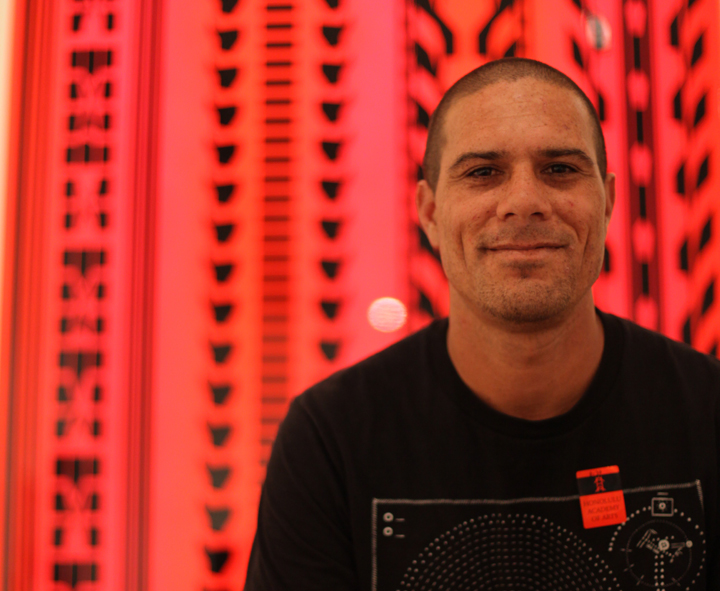
Portrait by Aaron Yoshino
Art image by Sally Lundburg
The life experiences of Hawaii artist Keith Tallett is the inspiration behind his work.
The Honolulu Academy of Arts is tranquil at eleven o’clock in the morning when I meet artist Keith Tallett. He is tall, sports a shaved head, and his attire – a black graphic T-shirt, colorful surf shorts and Reef slippers – throws me off for a second. We trade pleasantries and jet towards the gallery in the back of the museum, where three of his pieces are on display as part of Artists of Hawai‘i 2011.
Inside, people weave through the pedestals and false walls, their eyes hopscotching from photograph to painting to sculpture. Tallett walks towards a glossy, monolithic slab and stands right in front of it. The fetishistic finish of the piece, comprised of layers of resin and fiberglass, glints under the spotlights.
“It’s kind of counter-cultural and lowbrow,” says Tallett, referring to his using the materials and procedures of surfboard shaping in his paintings. He is soft-spoken yet articulate, with a penchant for peppering serious art talk with local colloquialisms. The painting, I realize, is not hanging flat against the wall; it’s propped up against it, like a surfboard.
“It’s a three-dimensional form that you interact with,” says Tallett, who didn’t want his pieces to simply rest flush against the wall in the way that, say, traditional paintings do. He insists that his works proffer an experiential element, and it’s true: stand close enough, and the patterns and surface envelop you. “That’s the whole thing about surfing and the materials I use,” Tallett adds. “You have to experience it, you have to feel it.”
Growing up in Hilo, making art wasn’t a part of Tallett’s life. In fact, the idea of being an artist didn’t occur to him until college, in Los Angeles, where he took his first painting classes. He realized his experiences in Hilo primed him for life as an artist. “Hawaiian or plantation culture did very resourceful things, but they never called it art,” he says. “My dad made skateboards and surfboards, and it wasn’t like painting them was hip or artistic, it was just out of necessity!”


Tallett returned home, obtained his bachelor of fine arts degree in painting from University of Hawai‘i, Hilo, then headed back to California, where he pursued his master’s degree in painting at San Francisco Art Institute. There, he encountered harsh criticism. “I got whooped my first semester,” he remembers.
He returned home, however, and had an epiphany. “When I came back to Hawai‘i on a break, I ended up surfing and making boards, and, ‘uh-oh,’ a light bulb went off in my head.” He soon began to import the procedures and ideas of surfboard construction into his paintings. He cleared out his studio, sold his oil paints, and started from scratch.
While Tallett explains the genesis of his pieces, a crowd of students quickly accumulates around us. It turns out they are a class from Punahou School. One student asks a question about the patterns Tallett uses, which I naively thought were derived from Polynesian tattoos.
“These prints are all tire marks,” he explains. “They’re actually tire treads.”
“Ohhh,” everyone says, in unison.
“I wanted to have a pattern that’s universal,” Tallett elaborates. “You’re on these patterns that go around, that are used and discarded everyday, and we don’t know anything about them.”
His own artistic practices aside, Tallett and his wife, the artist Sally Lundburg, form one-half of Aggroculture – a Hamakua-based art collective – with another art couple, Scott Yoell and Margo Ray. Given the diminutive size and relative insularity of the Big Island’s art scene, it provides them with a support system in a place with very little. “For me and the people in Aggroculture, we need to figure out how to do this and get it out, and just get the audience more aware,” says Tallett.
We part ways. Tallett throws me an open-handed shaka before disappearing into the gallery. I go back, one last time, to look at his paintings. Gazing at the reflective surfaces of his large-scale, candy-colored paintings, I think to myself, this is not what ‘local art’ is supposed to look like. Or is it?
For more information visit keithtallett.com or agrroculture.org.

